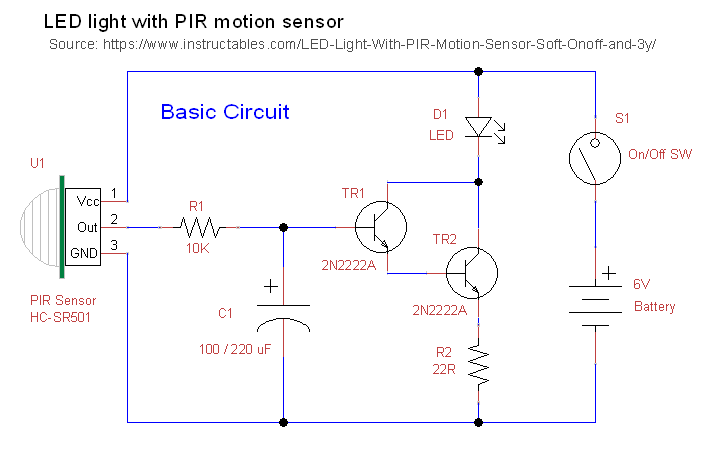I would like to make some LED lamps for night use, therefore at low intensity, just enough to see where you are walking, but almost without waking up. ;-)
It should only turn on when it detects movement and turn off after a certain time.
It must work at low DC voltage (because it is common to have small unused power supplies or easy to build a battery pack).
The basic circuit:
Source: https://www.instructables.com/LED-Light-With-PIR-Motion-Sensor-Soft-Onoff-and-3y/
Among the many circuits available on the net I chose this one, for a few reasons.
Employs a common PIR sensor, requires few components and appears set to not consume more than necessary.
Not least and unlike many other similar circuits, it includes an RC (Time Constant) filter for soft-on, soft-off functionality, which I'd like to keep.
Unfortunately, the author does not explain in detail all the calculations made.
Simply I'm not experienced enough to do without it.
So I would like a small guide that highlights the right procedure, formulas and calculations to define the value of the components, for a specific LED array. How to adapt the circuit to a given load avoiding waste of current, and perhaps how to verify that it works in the best conditions.
The first revision of the basic circuit, should have:
Basic parameters:
- HC-SR501 PIR sensor for motion detection.
- Use of standard 5 mm. LEDs (see the table), single or LED array (always of exactly the same type of LED)
- Regulated DC power supply between 5 and 12V (15V max.), chosen according to the number of LEDs used.
- Soft-on, soft-off function (RC Time Constant filter).
Notes and Questions:
- The Author used the BJTs he had (2N2222A). The NPN transistors I have are: BC547B/C, BC548B/C (all, max 100 mA), PN2222A (500 mA), MPS2222AG (600 mA) and SS8050 (1.5 A).
Among them, which ones would be the more suited for this circuit? - Since in a Darlington pair it's the second transistor (TR2) that does the hardest work, is it better to use different transistors or to keep an identical pair anyway, perhaps to simplify the calculations?
- My multimeter can measure the hfe of NPN and PNP transistors. I guess this can help.
Circuit Rev. 2
Thinking about a second revision, I would like to know how to add an LDR photoresistor to detect ambient light and activate the circuit only below a certain threshold. I've seen many examples, but I don't know how to integrate it into this specific circuit.
Thank you in advance.




